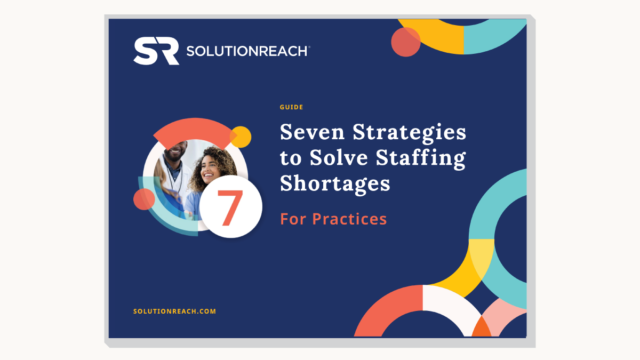Though a certain amount of healthcare worker and staff turnover is expected at any practice, a high turnover rate can be a major setback to your success. And given ongoing market pressures on practices, the impacts of the pandemic, and the “Great Resignation,” healthcare organizations can ill afford to absorb costly hiring expenses when your front office becomes a revolving door.
The cost of losing an admin team member can be as much as one-half to two times the person’s salary. Even replacing an entry-level staff member can total up to 25% of the employee’s salary.
In this article, we’ll look at some of the impacts of high staff turnover, how to calculate your practice’s turnover rate, and some approaches to upgrade new hire onboarding to ensure it helps boost office productivity, keep costs down, and enable you to retain the best talent.
What is considered a high turnover rate, and how can it negatively impact my healthcare practice?
Common front office turnover rates can hover around 20%. For small practices, not only can that kind of rate prevent you from reaching your business goals, but it can also weaken your ability to provide the best patient care experience. And that’s just the tip of the iceberg.
High turnover rates sap your practice’s productivity because you’re continually diverting time and resources to recruit and train new employees. There’s also no guarantee you can quickly or easily replace staff members who leave. One study found that 77% of dental practices seeking to hire admin team members found it extremely or very difficult to fill those positions.
High turnover also unavoidably puts a greater workload on your remaining staff members. Over time, this can lead to employee burnout, which only serves to perpetuate the vicious cycle of turnover. A short-staffed office also hampers your ability to book the same volume of appointments, recall activities, and other revenue-generating tasks and weaken your ability to provide a top patient experience.
Worst of all, your patients will notice the drop in personal attention given to their needs. 96% of patient complaints are due to poor customer service, and 44% say they will switch practices if they get a subpar patient experience, or worse, patient outcome.
How do I calculate my healthcare practice’s employee turnover rate?
To easily know your turnover rate, divide the number of employee terminations (voluntary and involuntary) over a specific length of time by the number of people employed during that time, and then multiply that figure by 100. For example, if you start the year with 5 total front-line staff employees, and during the year, 1 person leaves, your turnover is 1 divided by 5 equals 0.20, which gives you a 20% turnover rate.
Of course, a key variable here in measuring the true impact of your turnover rate is the time period. A 20% turnover over 5 years is much more manageable and sustainable than to cope with personnel changes every year.
How can the right approach to training help prevent high turnover and boost your team’s effectiveness?
A 2023 MGMA poll asked medical providers to rate their biggest front desk training challenges, and respondents noted the following:
- 26% scheduling
- 26% customer service
- 23% payments
- 13% technology/EHR
Let’s take a closer look at how placing a higher priority on some of these tricky training areas can also better support your practice’s front-office success. Investing in a quality, results-driven training program can give new team members the strong foundation they need to contribute more meaningfully to the overall patient satisfaction for your practice, from the start.
Customer service
Front office staff are the first point of contact for your patients, so it’s vital that they have excellent customer service skills. This should include how to properly greet patients, communicate effectively, and handle complaints.
Appointment scheduling
Your admin team has to know the ways to efficiently book appointments while also managing your office schedule. This should include making different appointment types and appointment lengths, while also knowing scheduling guidelines and best practices. Emphasize the importance of appointment reminders in aiding them to reach more patients more effectively to minimize no-shows and better manage office tasks.
Insurance verification and billing
Underscore pre-appointment tasks like verifying patient insurance eligibility, determining patient financial responsibility, and confirming care are covered before a patient arrives. They’ll also need a firm grasp of billing, collections, and how they can help patients have a better payment experience while increasing your accounts receivable by sending payment request messages. Training should also include knowledge of insurance plans, copays, deductibles, and how to process claims.
HIPAA compliance
Your staff members need to understand HIPAA, similar patient privacy laws, and the critical nature of safeguarding patients’ protected health information (PHI). Ensure training provides an understanding of patient communication consent guidelines, confidentiality, and how to handle security breaches.
Technology
Explain how your electronic health record (EHR) or practice management (PM) system integrates with your patient communication functions for appointment reminders, recall notices, payment requests, and intake forms. Consolidating your tech stack licenses under a single patient communications platform can reduce your technology costs while making it much easier for new hires to quickly learn the ropes on how to efficiently reach patients. At the same time, you’ll boost your admin team’s ability to work more productively,to focus on priority tasks, and give your patients a more personalized experience.
Office policy and procedures
Front-line healthcare staff members should be trained in office policies and procedures as they’re starting their new job, including safety protocols, emergency procedures, and the use of office equipment. When possible, it’s also beneficial to create a work environment that cross-trains employees to help them gain new skills and to provide your office with greater flexibility when employees are out on PTO or due to illness to maintain a healthy work-life balance. Provide an experienced mentor to help new hires hone their skills, increase their knowledge, work independently sooner, and consider career advancement options.
Key Takeaways
Reduce high turnover in your front office by giving new admin team members the level of quality training and tools they need to succeed. Better position your office for the retention of top talent and grow employee engagement, job satisfaction, and well-being by ensuring new hires receive the onboard training required to be more effective in their roles. Your patients will not only get a better appointment experience with improved retention strategies, but you’ll also be able to develop the type of team longevity that will help cut the average cost of turnover and increase your practice’s profitability.

To learn more tips, tricks, and secrets on how to attract, develop, and retain top front office talent and solve your high turnover merry-go-round, download the guide, “Seven Strategies to Solve Staffing Shortages for Practices.”
Read the Guide


